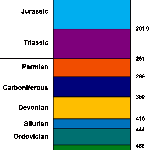

Fossils in the Classroom Materials and Resources
Geologic Time Scale | Lab Investigation Summaries and Colorado State Academic Standard Information | Online Resources for Teachers and Students | Home
Geologic Time Scale – download [240 KB]
Paleozoic Era – download [12.7 MB]
Mesozoic Era – download [1.53 MB]
Cenozoic Era – download [321 KB]
Geology Background
The history of life on our planet has travelled a long and winding path. Much of what we know about how life has evolved comes from fossils. Both the physical remains of organisms and the record of behaviors captured as trace fossils tell us about where, how, and who has been in different places at different times. Understanding the fossil record takes a lot of detective work through constant development and testing of hypotheses. It also takes scientists with many different areas of expertise: biochemistry, statistics, biomechanics, ecology, and of course, geology. Understanding geology is critical to doing paleontology because fossils are preserved in rocks, and the characteristics of the rocks that hold fossils can be as informative as the fossils themselves.
Almost all fossils are preserved in sedimentary rocks. This is primarily because sedimentary rocks are the main type formed at or near the surface of the earth where all the organisms live. There are some exceptions, such as lava, which can occasionally surround tree trunks and preserve them as casts, but these are pretty rare. The rock cycle is how geologists describe the interplay between the three main types of rocks: metamorphic rocks, igneous rocks and sedimentary rocks. Metamorphic rocks are formed under high heat and pressure, which generally destroys any fossils that were in the rocks before they were metamorphosed. Marble is an example of a metamorphic rock that generally forms by pressure cooking limestone until all the minerals it is composed of re-form into new crystals. Igneous rocks are formed from molten rock either at the surface (lava) or underground (as granites or other similar rocks), its molten nature generally makes it unsuitable for preserving organic material. Sedimentary rocks are built from pieces of pre-existing rocks.
As rocks at the Earth's surface weather (break down by physical or chemical means) the particles move by forces such as water and wind into low places where they collect. Organisms that live in topographically low areas (such as lakes or ocean basins) have the best chance of being preserved since they are already in places where sediment is likely to bury them and keep them free from scavengers and decay. Examples of sedimentary rocks that tend to have fossils are mudstones, shales and limestones. The smaller the grains of sediment that make up the rock, the better they seal out oxygen and the more detail they are likely to preserve. As the layers of sediment build up on top of one another, they create a physical timeline. The oldest layers, along with the organisms that were fossilized as they formed, are deepest. The youngest layers are formed at the top. Reading the layers is complicated by the fact that as continents move and mountains rise, the layers are often tipped sideways and perturbed in other ways.
Throughout the Earth's history, each of these three rock types has been continuously formed and recycled into other types of rocks. This makes the rock record fragmentary in its nature, but enough rock has been produced throughout time to tell us a lot about the history of our planet.
Geologic Time
Geologic Time is a crucial concept to understanding the history of the earth – including the evolution of life. Many different representations of the timeline have been created, and many approaches developed by informed, trusted sources. We will provide a list of web sites with relevant information.
We are including several pages with Geologic Time Scale data for use in the classroom. We suggest using a threefold approach to connect with the investigations in the Fossil Kit.
-
Each group working on an investigation should have a time scale so that they can locate the time that is relevant to the set of fossils they are working with. As they work through the investigation, the group should come to a consensus about where on the time line they are.
-
Each student should have a copy of the time scale that they can use when they are working on the investigations. As they come to consensus with the group, they should locate the relevant time on their timeline and draw a picture of some of the plants and animals living at the time.
-
There should be a large shared time scale that is constructed by the class as a whole. This will be a starting point for discussion of the investigations the students have completed. Start with a blank sheet of kraft paper the height of the blackboard. The most important divisions for students to focus on are the Eras.
-
The Paleozoic, Mesozoic and Cenozoic are the eras during which there is life on earth. We have included charts for each of these, with images of some of the life forms that were abundant during these times.
-
Students should search for other images online, or draw pictures of plants and animals to place on the time scale. Thought should be given to both when an organism appears on the time scale and when it is gone because it has become extinct.
-
In addition to organisms, the images of the continents at different geologic time points can also be placed on the time scale. The complete set of these images can be found at: http://www.scotese.com/.
-
http://www.stratigraphy.org/column.php?id=Chart/Time%20Scale
http://www.ucmp.berkeley.edu/exhibits/geologictime.php
http://nsdl.org/resource/2200/20061003230008455T
http://www.windows.ucar.edu/tour/link=/earth/past/geologic_time.html
http://www.actionbioscience.org/education/lewis_lampe_lloyd.html
http://serc.carleton.edu/NAGTWorkshops/time/visualizations/geotime.html



